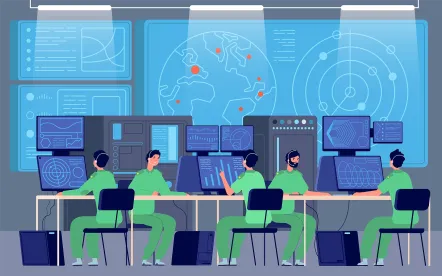On October 31, 2022, Jennifer A. Abruzzo, General Counsel for the National Labor Relations Board (NLRB), issued a Memorandum regarding new challenges that employers will face for the electronic monitoring and algorithmic management of employees.
Electronic Surveillance
The Memorandum explains that an increase in technology availability has resulted in employers’ increasing use of these technologies to closely monitor and manage employees. For example, employers record workers’ conversations and track their movements using wearable devices, security cameras, and radio-frequency identification badges. On the road, they use GPS tracking devices and cameras. With respect to employees who use the computer for their work, Abruzzo identified that employers use keyloggers and software that takes screenshots, webcam photos, and audio recordings. Further, the Memorandum points out that this type of monitoring also reaches into employees’ time outside of work, even before actual employment begins.
Current Regulations
According to Abruzzo, many of these practices are unlawful under the current existing regulations. Employer surveillance of employees’ picketing and handbilling tends to intimidate, and thus violates the National Labor Relations Act (NLRA). Also, utilizing new technologies or expanding the use of existing ones in response to protected activities violates Section 8(a)(1) even if it only creates an impression of surveillance. Further, Abruzzo identified that an employer may be found to be in violation of Section 8(a)(3) if it uses artificial intelligence to screen job applicants, discipline its employees, or apply production quotas or efficiency standards to terminate union supporters. An employer also violates Section 8(a)(5) if it fails to bargain for the right to implement tracking technologies and to use the accumulated data.
Proposed Additional Restrictions
Abruzzo indicated that, in addition to zealously enforcing current regulations, she will urge the NLRB “to adopt a new framework for protecting employees from intrusive or abusive forms of electronic monitoring and automated management that interfere with Section 7 activity.” She stated that “employers cannot lawfully prevent discussions about such matters, even during working time, if (as is often the case) they permit other kinds of non-work discussions.” In addition, “time outside working hours, whether before or after work, or during luncheon or rest periods, is an employee’s time to use as the employee wishes without unreasonable restraint, although the employee is on company property.” Further, Abruzzo emphasized the importance of confidentiality and reiterated that employees’ unionizing activities can be kept secret from an employer. Thus, “constant surveillance and management through electronic means threaten employees’ basic ability to exercise their rights.”
According to the Memorandum, if electronic surveillance, the breakneck pace of work set by automated systems, an extension of surveillance to the break time and nonwork areas, or even excessive workloads “prevent workers from taking their breaks together or at all, they may be unable to engage in solicitation or distribution of union literature during nonworking time.” Also, the reach of surveillance or even technology use that “makes employees reasonably fear such far-reaching surveillance” may prevent employees from exercising their Section 7 rights anywhere.
Under the new guidance issued in the Memorandum, in addressing whether the surveillance violates the NLRA, the NLRB will balance employees’ rights to concerted activities against the employer’s legitimate business reasons for using some forms of electronic monitoring and automated management. An employer may be found in violation of Section 8(a)(1) if the NLRB finds that “an employer has presumptively violated Section 8(a)(1) where the employer’s surveillance and management practices, viewed as a whole, would tend to interfere with or prevent a reasonable employee from engaging in activity protected by the Act.” “If the employer’s business need outweighs employees’ Section 7 rights, unless the employer demonstrates that special circumstances require covert use of the technologies, [Abruzzo] will urge the Board to require the employer to disclose to employees the technologies it uses to monitor and manage them, its reasons for doing so, and how it is using the information it obtains.”
To enforce current regulations and the new guidance, among other things, the NLRB will facilitate information sharing and coordinate the enforcement of these issues with the Federal Trade Commission, the Consumer Financial Protection Bureau, the Department of Justice, the Equal Employment Opportunity Commission, and the Department of Labor, upon recently signed agreements.
The Bottom Line
Abruzzo has made it very clear that she plans to vigorously enforce this guidance in cases involving new workplace technologies. With that in mind, employers should review their current policies and procedures regarding the use of any electronic devices that they use to control their facilities and their employees. Further, any electronic monitoring and algorithmic management technologies should be used only by those employers that have a legitimate business reason to do so. Otherwise, depending on the circumstances, employers will be under threat of facing NLRB charges for violations of an employee’s right to concerted activities.





 />i
/>i
